The Future of Healthcare Informatics: Roles, Connected Health, Impact
VerifiedAdded on 2022/08/21
|9
|2033
|37
Essay
AI Summary
This essay delves into the evolving landscape of healthcare informatics, examining the crucial roles and responsibilities of nurse informaticists in the digital healthcare environment. It analyzes the concept of connected health, providing examples such as lifestyle coaching programs, telehealth initiatives, and patient monitoring systems for older adults, along with their respective advantages and disadvantages. The essay also explores the significant impact of informatics on public health, illustrating this through examples of improved patient medical history access, enhanced treatment effectiveness analysis, and better coordination among medical specialists. Furthermore, it identifies the current and predicts the future role of the informatics nurse, emphasizing the increasing importance of data analytics and technological integration in providing quality patient care. The essay highlights the transformative potential of informatics in making healthcare more accessible, efficient, and effective, ultimately improving public health outcomes.
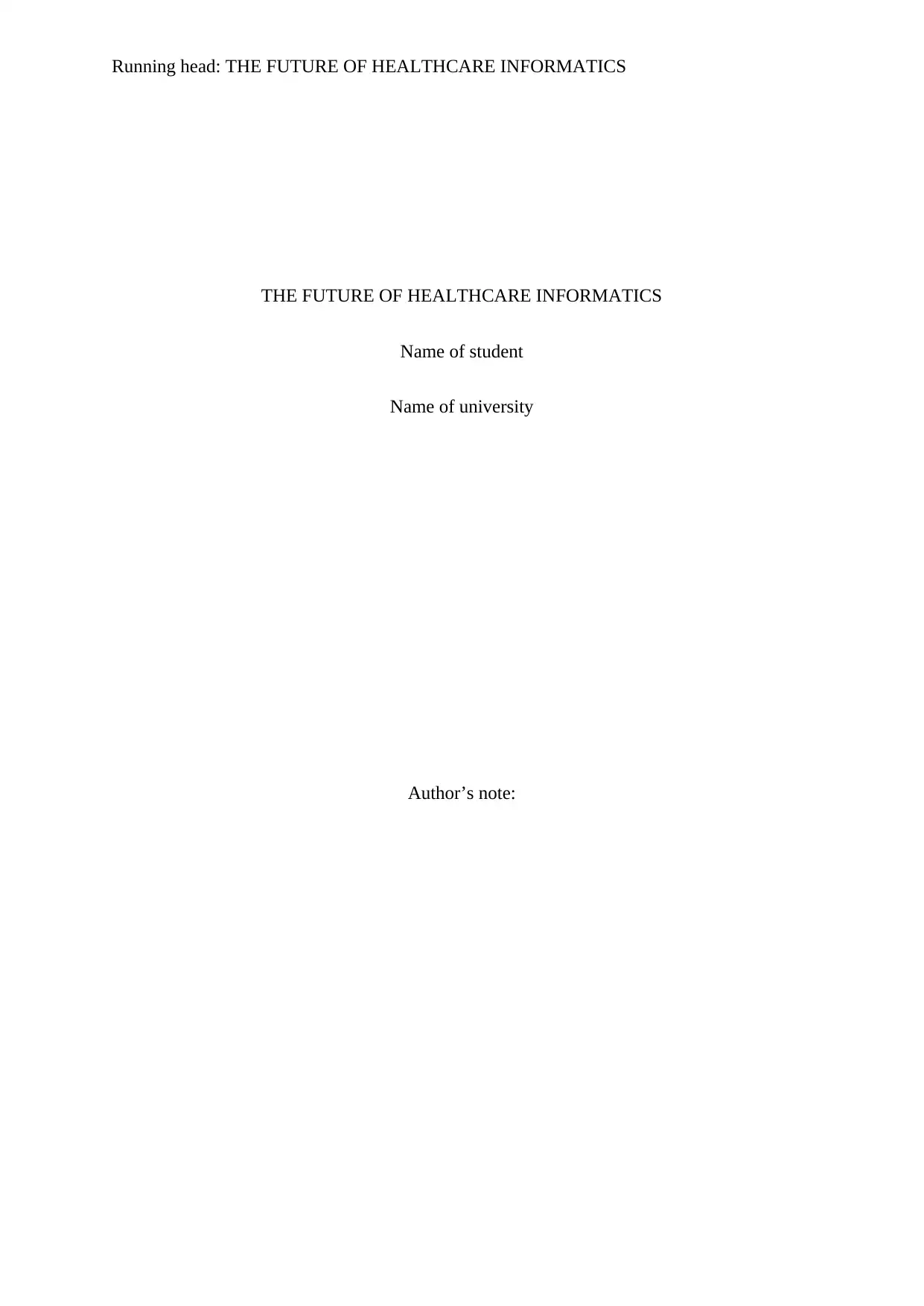
Running head: THE FUTURE OF HEALTHCARE INFORMATICS
THE FUTURE OF HEALTHCARE INFORMATICS
Name of student
Name of university
Author’s note:
THE FUTURE OF HEALTHCARE INFORMATICS
Name of student
Name of university
Author’s note:
Paraphrase This Document
Need a fresh take? Get an instant paraphrase of this document with our AI Paraphraser
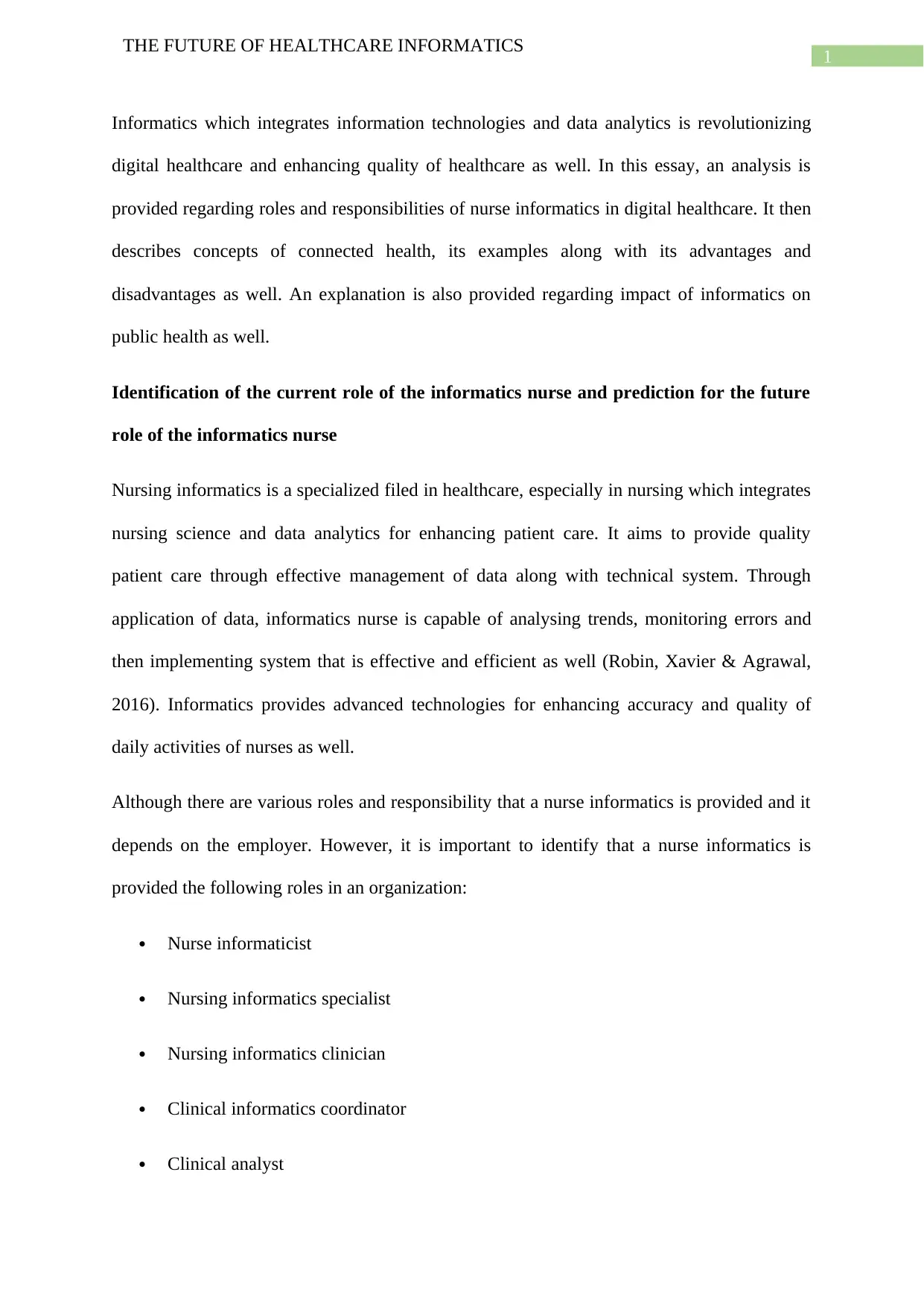
1
THE FUTURE OF HEALTHCARE INFORMATICS
Informatics which integrates information technologies and data analytics is revolutionizing
digital healthcare and enhancing quality of healthcare as well. In this essay, an analysis is
provided regarding roles and responsibilities of nurse informatics in digital healthcare. It then
describes concepts of connected health, its examples along with its advantages and
disadvantages as well. An explanation is also provided regarding impact of informatics on
public health as well.
Identification of the current role of the informatics nurse and prediction for the future
role of the informatics nurse
Nursing informatics is a specialized filed in healthcare, especially in nursing which integrates
nursing science and data analytics for enhancing patient care. It aims to provide quality
patient care through effective management of data along with technical system. Through
application of data, informatics nurse is capable of analysing trends, monitoring errors and
then implementing system that is effective and efficient as well (Robin, Xavier & Agrawal,
2016). Informatics provides advanced technologies for enhancing accuracy and quality of
daily activities of nurses as well.
Although there are various roles and responsibility that a nurse informatics is provided and it
depends on the employer. However, it is important to identify that a nurse informatics is
provided the following roles in an organization:
Nurse informaticist
Nursing informatics specialist
Nursing informatics clinician
Clinical informatics coordinator
Clinical analyst
THE FUTURE OF HEALTHCARE INFORMATICS
Informatics which integrates information technologies and data analytics is revolutionizing
digital healthcare and enhancing quality of healthcare as well. In this essay, an analysis is
provided regarding roles and responsibilities of nurse informatics in digital healthcare. It then
describes concepts of connected health, its examples along with its advantages and
disadvantages as well. An explanation is also provided regarding impact of informatics on
public health as well.
Identification of the current role of the informatics nurse and prediction for the future
role of the informatics nurse
Nursing informatics is a specialized filed in healthcare, especially in nursing which integrates
nursing science and data analytics for enhancing patient care. It aims to provide quality
patient care through effective management of data along with technical system. Through
application of data, informatics nurse is capable of analysing trends, monitoring errors and
then implementing system that is effective and efficient as well (Robin, Xavier & Agrawal,
2016). Informatics provides advanced technologies for enhancing accuracy and quality of
daily activities of nurses as well.
Although there are various roles and responsibility that a nurse informatics is provided and it
depends on the employer. However, it is important to identify that a nurse informatics is
provided the following roles in an organization:
Nurse informaticist
Nursing informatics specialist
Nursing informatics clinician
Clinical informatics coordinator
Clinical analyst
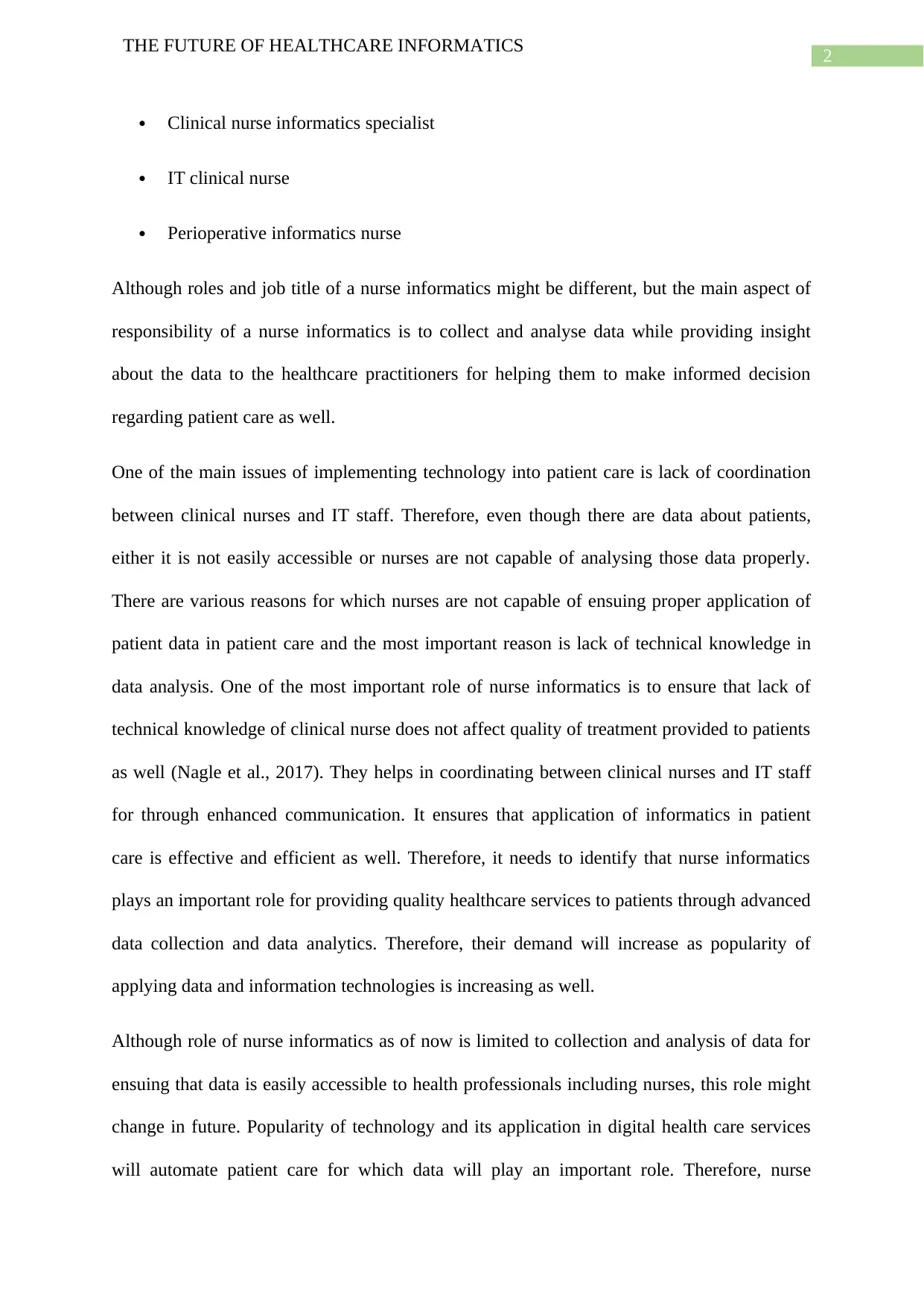
2
THE FUTURE OF HEALTHCARE INFORMATICS
Clinical nurse informatics specialist
IT clinical nurse
Perioperative informatics nurse
Although roles and job title of a nurse informatics might be different, but the main aspect of
responsibility of a nurse informatics is to collect and analyse data while providing insight
about the data to the healthcare practitioners for helping them to make informed decision
regarding patient care as well.
One of the main issues of implementing technology into patient care is lack of coordination
between clinical nurses and IT staff. Therefore, even though there are data about patients,
either it is not easily accessible or nurses are not capable of analysing those data properly.
There are various reasons for which nurses are not capable of ensuing proper application of
patient data in patient care and the most important reason is lack of technical knowledge in
data analysis. One of the most important role of nurse informatics is to ensure that lack of
technical knowledge of clinical nurse does not affect quality of treatment provided to patients
as well (Nagle et al., 2017). They helps in coordinating between clinical nurses and IT staff
for through enhanced communication. It ensures that application of informatics in patient
care is effective and efficient as well. Therefore, it needs to identify that nurse informatics
plays an important role for providing quality healthcare services to patients through advanced
data collection and data analytics. Therefore, their demand will increase as popularity of
applying data and information technologies is increasing as well.
Although role of nurse informatics as of now is limited to collection and analysis of data for
ensuing that data is easily accessible to health professionals including nurses, this role might
change in future. Popularity of technology and its application in digital health care services
will automate patient care for which data will play an important role. Therefore, nurse
THE FUTURE OF HEALTHCARE INFORMATICS
Clinical nurse informatics specialist
IT clinical nurse
Perioperative informatics nurse
Although roles and job title of a nurse informatics might be different, but the main aspect of
responsibility of a nurse informatics is to collect and analyse data while providing insight
about the data to the healthcare practitioners for helping them to make informed decision
regarding patient care as well.
One of the main issues of implementing technology into patient care is lack of coordination
between clinical nurses and IT staff. Therefore, even though there are data about patients,
either it is not easily accessible or nurses are not capable of analysing those data properly.
There are various reasons for which nurses are not capable of ensuing proper application of
patient data in patient care and the most important reason is lack of technical knowledge in
data analysis. One of the most important role of nurse informatics is to ensure that lack of
technical knowledge of clinical nurse does not affect quality of treatment provided to patients
as well (Nagle et al., 2017). They helps in coordinating between clinical nurses and IT staff
for through enhanced communication. It ensures that application of informatics in patient
care is effective and efficient as well. Therefore, it needs to identify that nurse informatics
plays an important role for providing quality healthcare services to patients through advanced
data collection and data analytics. Therefore, their demand will increase as popularity of
applying data and information technologies is increasing as well.
Although role of nurse informatics as of now is limited to collection and analysis of data for
ensuing that data is easily accessible to health professionals including nurses, this role might
change in future. Popularity of technology and its application in digital health care services
will automate patient care for which data will play an important role. Therefore, nurse
⊘ This is a preview!⊘
Do you want full access?
Subscribe today to unlock all pages.

Trusted by 1+ million students worldwide
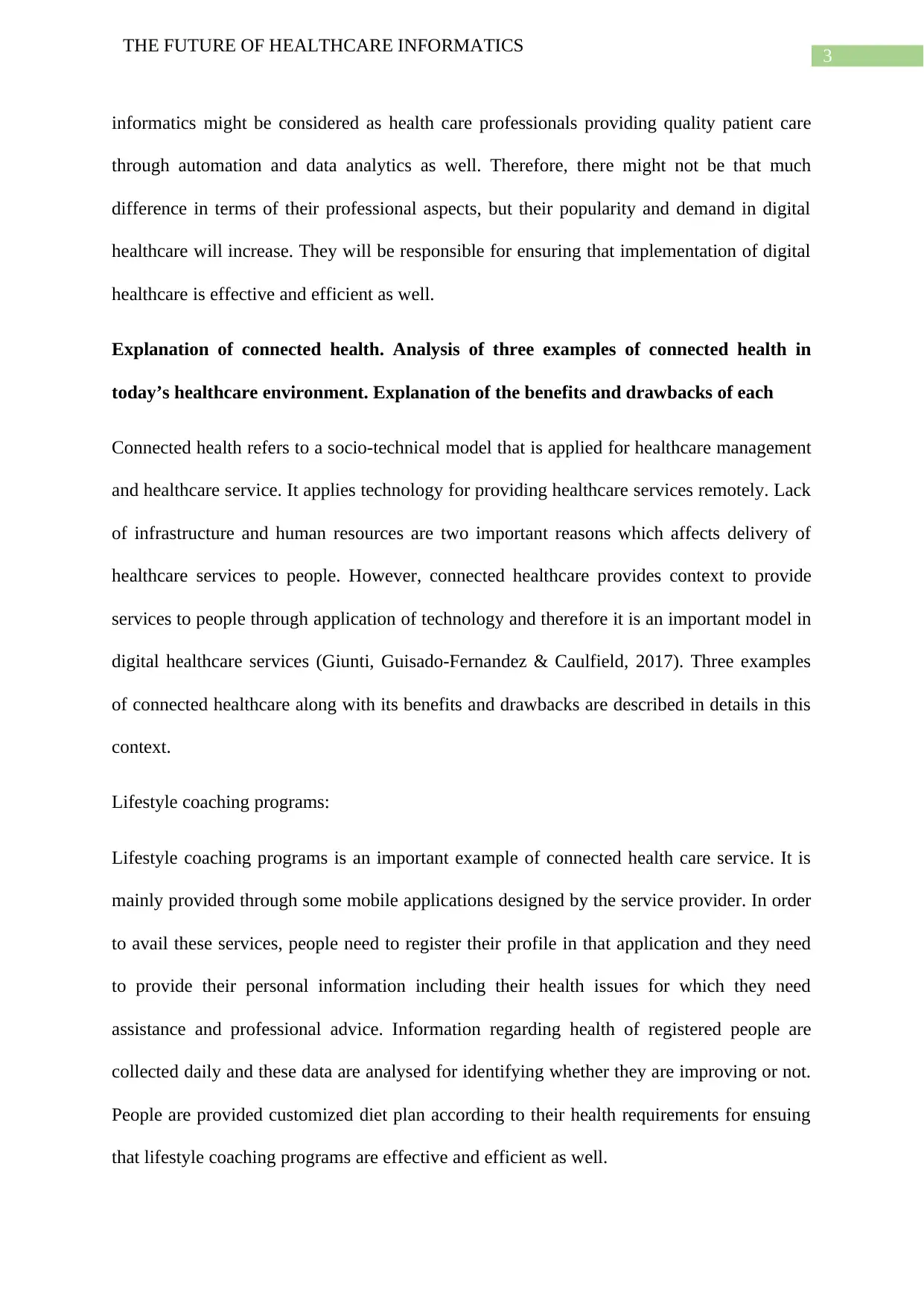
3
THE FUTURE OF HEALTHCARE INFORMATICS
informatics might be considered as health care professionals providing quality patient care
through automation and data analytics as well. Therefore, there might not be that much
difference in terms of their professional aspects, but their popularity and demand in digital
healthcare will increase. They will be responsible for ensuring that implementation of digital
healthcare is effective and efficient as well.
Explanation of connected health. Analysis of three examples of connected health in
today’s healthcare environment. Explanation of the benefits and drawbacks of each
Connected health refers to a socio-technical model that is applied for healthcare management
and healthcare service. It applies technology for providing healthcare services remotely. Lack
of infrastructure and human resources are two important reasons which affects delivery of
healthcare services to people. However, connected healthcare provides context to provide
services to people through application of technology and therefore it is an important model in
digital healthcare services (Giunti, Guisado-Fernandez & Caulfield, 2017). Three examples
of connected healthcare along with its benefits and drawbacks are described in details in this
context.
Lifestyle coaching programs:
Lifestyle coaching programs is an important example of connected health care service. It is
mainly provided through some mobile applications designed by the service provider. In order
to avail these services, people need to register their profile in that application and they need
to provide their personal information including their health issues for which they need
assistance and professional advice. Information regarding health of registered people are
collected daily and these data are analysed for identifying whether they are improving or not.
People are provided customized diet plan according to their health requirements for ensuing
that lifestyle coaching programs are effective and efficient as well.
THE FUTURE OF HEALTHCARE INFORMATICS
informatics might be considered as health care professionals providing quality patient care
through automation and data analytics as well. Therefore, there might not be that much
difference in terms of their professional aspects, but their popularity and demand in digital
healthcare will increase. They will be responsible for ensuring that implementation of digital
healthcare is effective and efficient as well.
Explanation of connected health. Analysis of three examples of connected health in
today’s healthcare environment. Explanation of the benefits and drawbacks of each
Connected health refers to a socio-technical model that is applied for healthcare management
and healthcare service. It applies technology for providing healthcare services remotely. Lack
of infrastructure and human resources are two important reasons which affects delivery of
healthcare services to people. However, connected healthcare provides context to provide
services to people through application of technology and therefore it is an important model in
digital healthcare services (Giunti, Guisado-Fernandez & Caulfield, 2017). Three examples
of connected healthcare along with its benefits and drawbacks are described in details in this
context.
Lifestyle coaching programs:
Lifestyle coaching programs is an important example of connected health care service. It is
mainly provided through some mobile applications designed by the service provider. In order
to avail these services, people need to register their profile in that application and they need
to provide their personal information including their health issues for which they need
assistance and professional advice. Information regarding health of registered people are
collected daily and these data are analysed for identifying whether they are improving or not.
People are provided customized diet plan according to their health requirements for ensuing
that lifestyle coaching programs are effective and efficient as well.
Paraphrase This Document
Need a fresh take? Get an instant paraphrase of this document with our AI Paraphraser
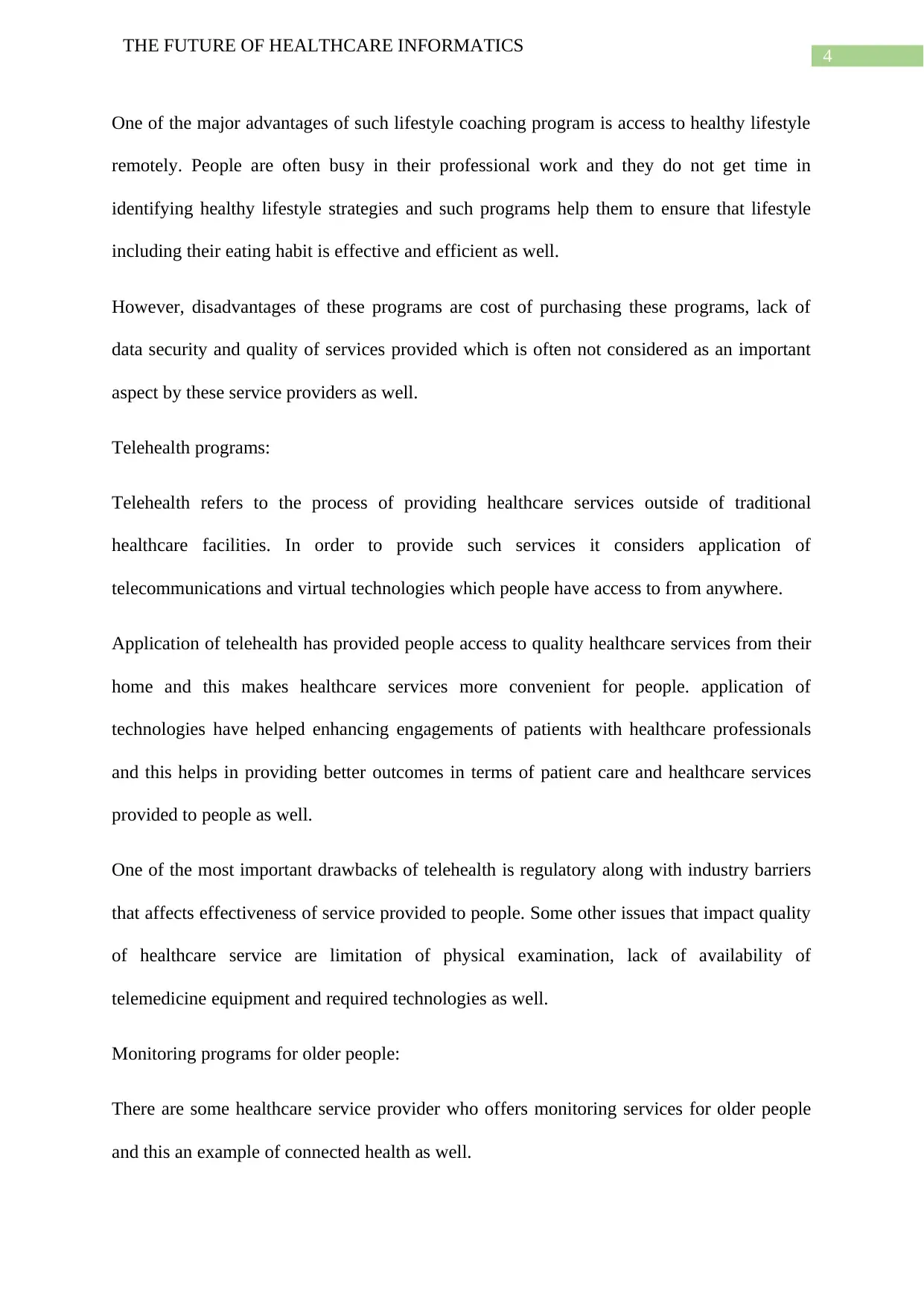
4
THE FUTURE OF HEALTHCARE INFORMATICS
One of the major advantages of such lifestyle coaching program is access to healthy lifestyle
remotely. People are often busy in their professional work and they do not get time in
identifying healthy lifestyle strategies and such programs help them to ensure that lifestyle
including their eating habit is effective and efficient as well.
However, disadvantages of these programs are cost of purchasing these programs, lack of
data security and quality of services provided which is often not considered as an important
aspect by these service providers as well.
Telehealth programs:
Telehealth refers to the process of providing healthcare services outside of traditional
healthcare facilities. In order to provide such services it considers application of
telecommunications and virtual technologies which people have access to from anywhere.
Application of telehealth has provided people access to quality healthcare services from their
home and this makes healthcare services more convenient for people. application of
technologies have helped enhancing engagements of patients with healthcare professionals
and this helps in providing better outcomes in terms of patient care and healthcare services
provided to people as well.
One of the most important drawbacks of telehealth is regulatory along with industry barriers
that affects effectiveness of service provided to people. Some other issues that impact quality
of healthcare service are limitation of physical examination, lack of availability of
telemedicine equipment and required technologies as well.
Monitoring programs for older people:
There are some healthcare service provider who offers monitoring services for older people
and this an example of connected health as well.
THE FUTURE OF HEALTHCARE INFORMATICS
One of the major advantages of such lifestyle coaching program is access to healthy lifestyle
remotely. People are often busy in their professional work and they do not get time in
identifying healthy lifestyle strategies and such programs help them to ensure that lifestyle
including their eating habit is effective and efficient as well.
However, disadvantages of these programs are cost of purchasing these programs, lack of
data security and quality of services provided which is often not considered as an important
aspect by these service providers as well.
Telehealth programs:
Telehealth refers to the process of providing healthcare services outside of traditional
healthcare facilities. In order to provide such services it considers application of
telecommunications and virtual technologies which people have access to from anywhere.
Application of telehealth has provided people access to quality healthcare services from their
home and this makes healthcare services more convenient for people. application of
technologies have helped enhancing engagements of patients with healthcare professionals
and this helps in providing better outcomes in terms of patient care and healthcare services
provided to people as well.
One of the most important drawbacks of telehealth is regulatory along with industry barriers
that affects effectiveness of service provided to people. Some other issues that impact quality
of healthcare service are limitation of physical examination, lack of availability of
telemedicine equipment and required technologies as well.
Monitoring programs for older people:
There are some healthcare service provider who offers monitoring services for older people
and this an example of connected health as well.
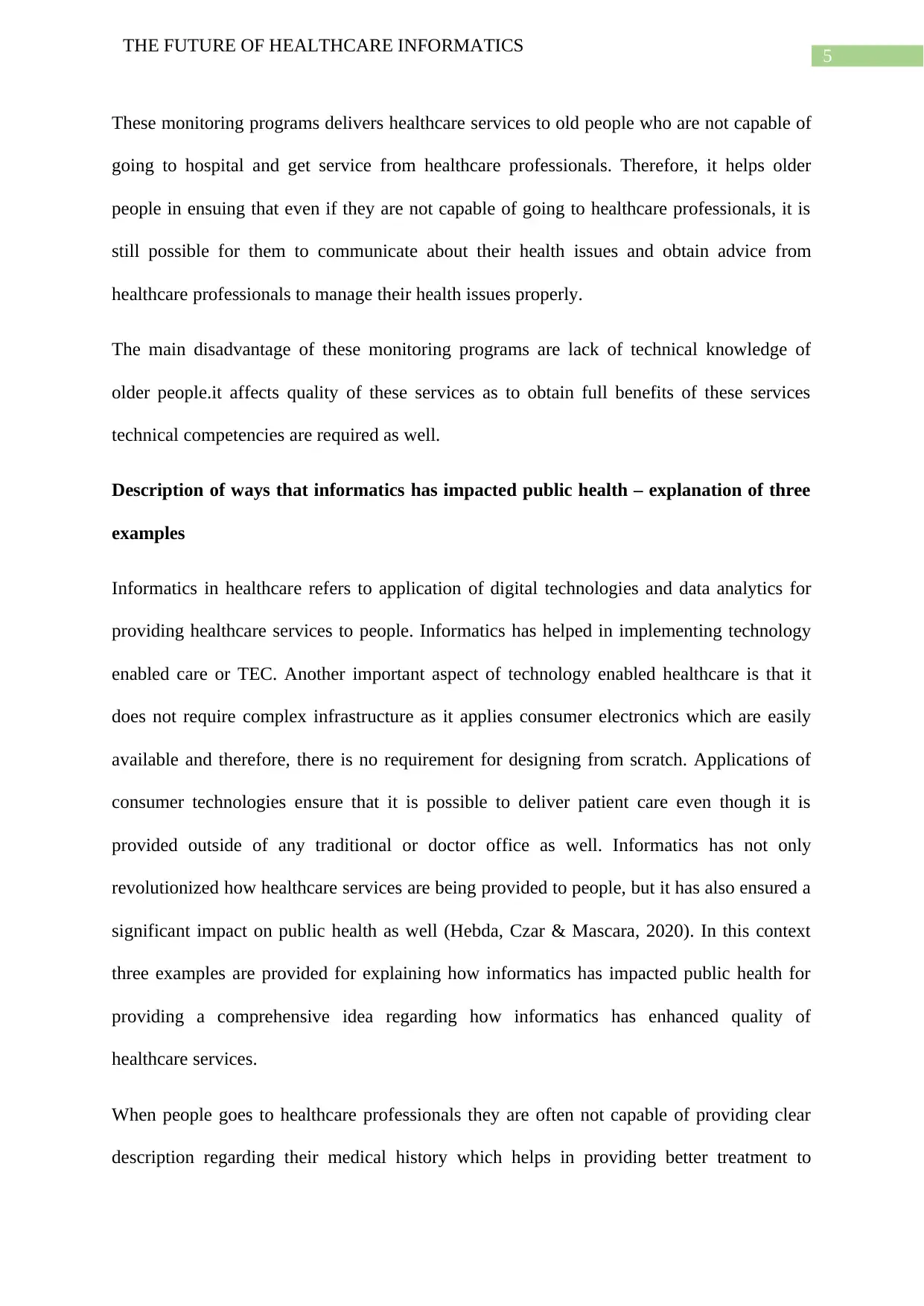
5
THE FUTURE OF HEALTHCARE INFORMATICS
These monitoring programs delivers healthcare services to old people who are not capable of
going to hospital and get service from healthcare professionals. Therefore, it helps older
people in ensuing that even if they are not capable of going to healthcare professionals, it is
still possible for them to communicate about their health issues and obtain advice from
healthcare professionals to manage their health issues properly.
The main disadvantage of these monitoring programs are lack of technical knowledge of
older people.it affects quality of these services as to obtain full benefits of these services
technical competencies are required as well.
Description of ways that informatics has impacted public health – explanation of three
examples
Informatics in healthcare refers to application of digital technologies and data analytics for
providing healthcare services to people. Informatics has helped in implementing technology
enabled care or TEC. Another important aspect of technology enabled healthcare is that it
does not require complex infrastructure as it applies consumer electronics which are easily
available and therefore, there is no requirement for designing from scratch. Applications of
consumer technologies ensure that it is possible to deliver patient care even though it is
provided outside of any traditional or doctor office as well. Informatics has not only
revolutionized how healthcare services are being provided to people, but it has also ensured a
significant impact on public health as well (Hebda, Czar & Mascara, 2020). In this context
three examples are provided for explaining how informatics has impacted public health for
providing a comprehensive idea regarding how informatics has enhanced quality of
healthcare services.
When people goes to healthcare professionals they are often not capable of providing clear
description regarding their medical history which helps in providing better treatment to
THE FUTURE OF HEALTHCARE INFORMATICS
These monitoring programs delivers healthcare services to old people who are not capable of
going to hospital and get service from healthcare professionals. Therefore, it helps older
people in ensuing that even if they are not capable of going to healthcare professionals, it is
still possible for them to communicate about their health issues and obtain advice from
healthcare professionals to manage their health issues properly.
The main disadvantage of these monitoring programs are lack of technical knowledge of
older people.it affects quality of these services as to obtain full benefits of these services
technical competencies are required as well.
Description of ways that informatics has impacted public health – explanation of three
examples
Informatics in healthcare refers to application of digital technologies and data analytics for
providing healthcare services to people. Informatics has helped in implementing technology
enabled care or TEC. Another important aspect of technology enabled healthcare is that it
does not require complex infrastructure as it applies consumer electronics which are easily
available and therefore, there is no requirement for designing from scratch. Applications of
consumer technologies ensure that it is possible to deliver patient care even though it is
provided outside of any traditional or doctor office as well. Informatics has not only
revolutionized how healthcare services are being provided to people, but it has also ensured a
significant impact on public health as well (Hebda, Czar & Mascara, 2020). In this context
three examples are provided for explaining how informatics has impacted public health for
providing a comprehensive idea regarding how informatics has enhanced quality of
healthcare services.
When people goes to healthcare professionals they are often not capable of providing clear
description regarding their medical history which helps in providing better treatment to
⊘ This is a preview!⊘
Do you want full access?
Subscribe today to unlock all pages.

Trusted by 1+ million students worldwide
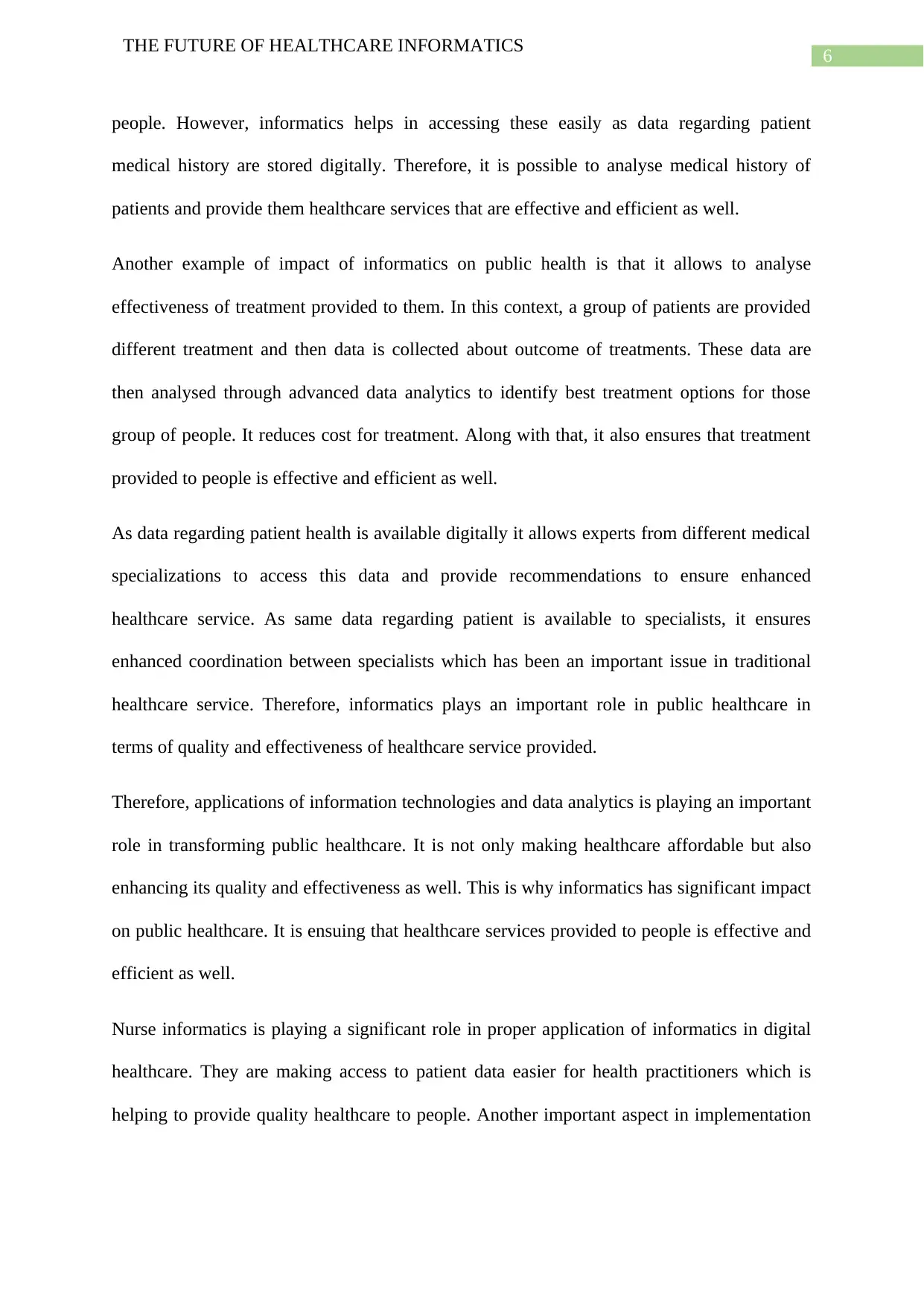
6
THE FUTURE OF HEALTHCARE INFORMATICS
people. However, informatics helps in accessing these easily as data regarding patient
medical history are stored digitally. Therefore, it is possible to analyse medical history of
patients and provide them healthcare services that are effective and efficient as well.
Another example of impact of informatics on public health is that it allows to analyse
effectiveness of treatment provided to them. In this context, a group of patients are provided
different treatment and then data is collected about outcome of treatments. These data are
then analysed through advanced data analytics to identify best treatment options for those
group of people. It reduces cost for treatment. Along with that, it also ensures that treatment
provided to people is effective and efficient as well.
As data regarding patient health is available digitally it allows experts from different medical
specializations to access this data and provide recommendations to ensure enhanced
healthcare service. As same data regarding patient is available to specialists, it ensures
enhanced coordination between specialists which has been an important issue in traditional
healthcare service. Therefore, informatics plays an important role in public healthcare in
terms of quality and effectiveness of healthcare service provided.
Therefore, applications of information technologies and data analytics is playing an important
role in transforming public healthcare. It is not only making healthcare affordable but also
enhancing its quality and effectiveness as well. This is why informatics has significant impact
on public healthcare. It is ensuing that healthcare services provided to people is effective and
efficient as well.
Nurse informatics is playing a significant role in proper application of informatics in digital
healthcare. They are making access to patient data easier for health practitioners which is
helping to provide quality healthcare to people. Another important aspect in implementation
THE FUTURE OF HEALTHCARE INFORMATICS
people. However, informatics helps in accessing these easily as data regarding patient
medical history are stored digitally. Therefore, it is possible to analyse medical history of
patients and provide them healthcare services that are effective and efficient as well.
Another example of impact of informatics on public health is that it allows to analyse
effectiveness of treatment provided to them. In this context, a group of patients are provided
different treatment and then data is collected about outcome of treatments. These data are
then analysed through advanced data analytics to identify best treatment options for those
group of people. It reduces cost for treatment. Along with that, it also ensures that treatment
provided to people is effective and efficient as well.
As data regarding patient health is available digitally it allows experts from different medical
specializations to access this data and provide recommendations to ensure enhanced
healthcare service. As same data regarding patient is available to specialists, it ensures
enhanced coordination between specialists which has been an important issue in traditional
healthcare service. Therefore, informatics plays an important role in public healthcare in
terms of quality and effectiveness of healthcare service provided.
Therefore, applications of information technologies and data analytics is playing an important
role in transforming public healthcare. It is not only making healthcare affordable but also
enhancing its quality and effectiveness as well. This is why informatics has significant impact
on public healthcare. It is ensuing that healthcare services provided to people is effective and
efficient as well.
Nurse informatics is playing a significant role in proper application of informatics in digital
healthcare. They are making access to patient data easier for health practitioners which is
helping to provide quality healthcare to people. Another important aspect in implementation
Paraphrase This Document
Need a fresh take? Get an instant paraphrase of this document with our AI Paraphraser
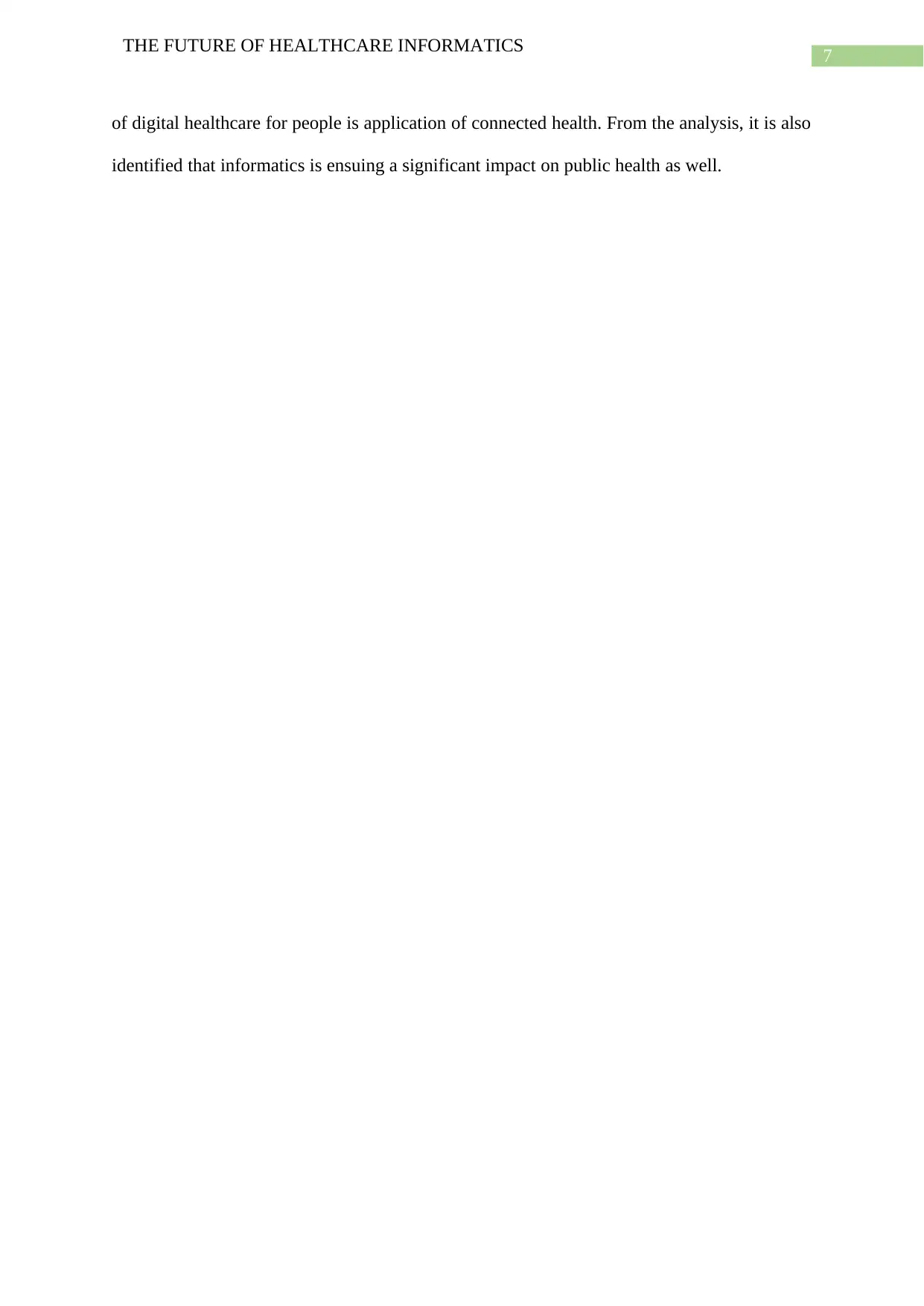
7
THE FUTURE OF HEALTHCARE INFORMATICS
of digital healthcare for people is application of connected health. From the analysis, it is also
identified that informatics is ensuing a significant impact on public health as well.
THE FUTURE OF HEALTHCARE INFORMATICS
of digital healthcare for people is application of connected health. From the analysis, it is also
identified that informatics is ensuing a significant impact on public health as well.
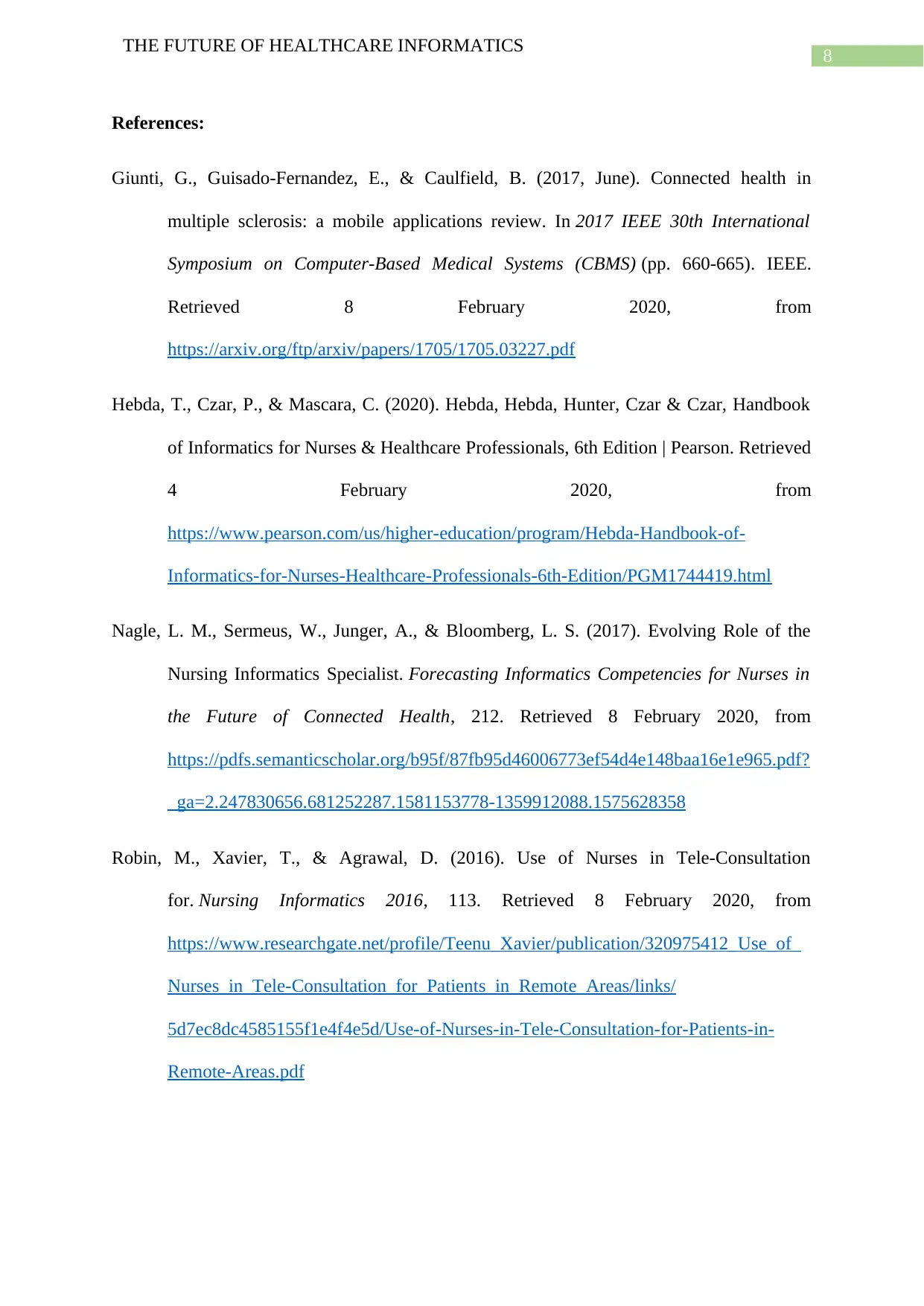
8
THE FUTURE OF HEALTHCARE INFORMATICS
References:
Giunti, G., Guisado-Fernandez, E., & Caulfield, B. (2017, June). Connected health in
multiple sclerosis: a mobile applications review. In 2017 IEEE 30th International
Symposium on Computer-Based Medical Systems (CBMS) (pp. 660-665). IEEE.
Retrieved 8 February 2020, from
https://arxiv.org/ftp/arxiv/papers/1705/1705.03227.pdf
Hebda, T., Czar, P., & Mascara, C. (2020). Hebda, Hebda, Hunter, Czar & Czar, Handbook
of Informatics for Nurses & Healthcare Professionals, 6th Edition | Pearson. Retrieved
4 February 2020, from
https://www.pearson.com/us/higher-education/program/Hebda-Handbook-of-
Informatics-for-Nurses-Healthcare-Professionals-6th-Edition/PGM1744419.html
Nagle, L. M., Sermeus, W., Junger, A., & Bloomberg, L. S. (2017). Evolving Role of the
Nursing Informatics Specialist. Forecasting Informatics Competencies for Nurses in
the Future of Connected Health, 212. Retrieved 8 February 2020, from
https://pdfs.semanticscholar.org/b95f/87fb95d46006773ef54d4e148baa16e1e965.pdf?
_ga=2.247830656.681252287.1581153778-1359912088.1575628358
Robin, M., Xavier, T., & Agrawal, D. (2016). Use of Nurses in Tele-Consultation
for. Nursing Informatics 2016, 113. Retrieved 8 February 2020, from
https://www.researchgate.net/profile/Teenu_Xavier/publication/320975412_Use_of_
Nurses_in_Tele-Consultation_for_Patients_in_Remote_Areas/links/
5d7ec8dc4585155f1e4f4e5d/Use-of-Nurses-in-Tele-Consultation-for-Patients-in-
Remote-Areas.pdf
THE FUTURE OF HEALTHCARE INFORMATICS
References:
Giunti, G., Guisado-Fernandez, E., & Caulfield, B. (2017, June). Connected health in
multiple sclerosis: a mobile applications review. In 2017 IEEE 30th International
Symposium on Computer-Based Medical Systems (CBMS) (pp. 660-665). IEEE.
Retrieved 8 February 2020, from
https://arxiv.org/ftp/arxiv/papers/1705/1705.03227.pdf
Hebda, T., Czar, P., & Mascara, C. (2020). Hebda, Hebda, Hunter, Czar & Czar, Handbook
of Informatics for Nurses & Healthcare Professionals, 6th Edition | Pearson. Retrieved
4 February 2020, from
https://www.pearson.com/us/higher-education/program/Hebda-Handbook-of-
Informatics-for-Nurses-Healthcare-Professionals-6th-Edition/PGM1744419.html
Nagle, L. M., Sermeus, W., Junger, A., & Bloomberg, L. S. (2017). Evolving Role of the
Nursing Informatics Specialist. Forecasting Informatics Competencies for Nurses in
the Future of Connected Health, 212. Retrieved 8 February 2020, from
https://pdfs.semanticscholar.org/b95f/87fb95d46006773ef54d4e148baa16e1e965.pdf?
_ga=2.247830656.681252287.1581153778-1359912088.1575628358
Robin, M., Xavier, T., & Agrawal, D. (2016). Use of Nurses in Tele-Consultation
for. Nursing Informatics 2016, 113. Retrieved 8 February 2020, from
https://www.researchgate.net/profile/Teenu_Xavier/publication/320975412_Use_of_
Nurses_in_Tele-Consultation_for_Patients_in_Remote_Areas/links/
5d7ec8dc4585155f1e4f4e5d/Use-of-Nurses-in-Tele-Consultation-for-Patients-in-
Remote-Areas.pdf
⊘ This is a preview!⊘
Do you want full access?
Subscribe today to unlock all pages.

Trusted by 1+ million students worldwide
1 out of 9
Related Documents
Your All-in-One AI-Powered Toolkit for Academic Success.
+13062052269
info@desklib.com
Available 24*7 on WhatsApp / Email
![[object Object]](/_next/static/media/star-bottom.7253800d.svg)
Unlock your academic potential
Copyright © 2020–2025 A2Z Services. All Rights Reserved. Developed and managed by ZUCOL.




